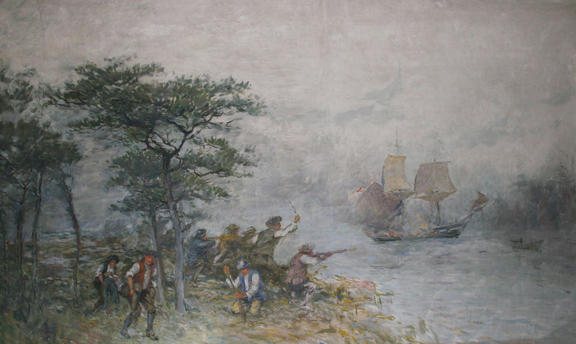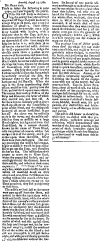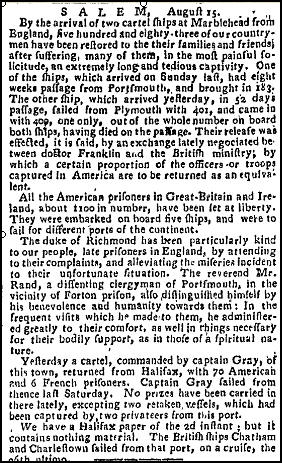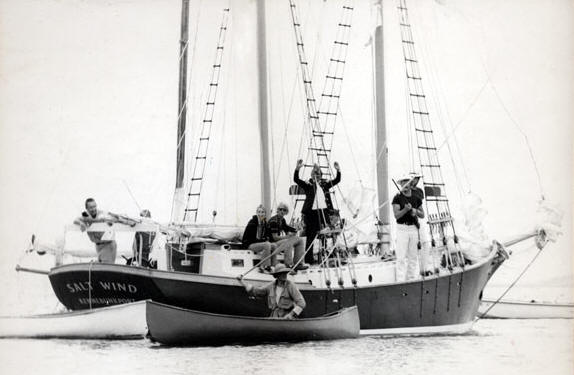Home Stage Island Gosnold Sects and the Settlement Battle of Cape Porpoise Goat Island Light 1872 Cape Porpoise Map Tyler Brook Old News Columns New Historical Research
|
Home Stage Island Gosnold Sects and the Settlement Battle of Cape Porpoise Goat Island Light 1872 Cape Porpoise Map Tyler Brook Old News Columns New Historical Research
|
The Revolutionary War Battle of Cape Porpoise, Maine

The Battle of Cape Porpoise painted as a mural in Judge Luques' house by Louis D. Norton in lieu of fine.
Sources for Cape Porpoise in the American Revolution at www.someoldnews.com
History is fluid. Scribes, text book publishers and cable news network producers accentuate aspects of events that best illustrate their points of view. The advent of digital archives on the Internet makes source records and historical newspapers available to us all.
Kennebunkport Historian, Charles Bradbury, described the Revolutionary War Battle of Cape Porpoise in his History of Kennebunkport published in 1937. He relied heavily on the memories of his older neighbors to piece together the harrowing events of August 8, 1782. The article transcribed below, which originally appeared in the New England Chronicle, October 3, 1782 and was reported from Arundel when events were fresh in the minds of all inhabitants, differs from Bradbury's 1837 account of the battle. "The enemy from the eastward" in Revolutionary War era newspapers, often refers to the British stronghold at Penobscot, today's Castine, Maine. Penobscot was also home to Loyalist Privateers who were infamous for raiding coastal Maine harbors for sheep, cattle and coasting vessels from Boston and Newbury, Massachusetts. Most notable was Loyalist, Captain Richard Pomroy and his 16 gun Brig Meriam. A few weeks after the attack at Cape Porpoise, Meriam was cut out of her anchor at Penobscot by Captain George Little in his American Navy Sloop Winthrop. The Brig Meriam was triumphantly sailed into Boston Harbor on Sept 16, 1782 along with 3 other prizes captured by Captain Little at Penobscot. They were, Privateer Schooner Hammond commanded by Penobscot Loyalist Doty, Sloop Ceres full of lumber for the West Indies and commanded by Penobscot Loyalist Peter Littlejohn and finally, an unnamed wood schooner that was a recent prize of the Brig Meriam. A letter published in the Massachusetts Archives, vol clviii, from the Governor relating to the success of Little's six week cruise said "I considered that he had most essentially prevented the Depredations on that coast by Capturing & sending into this Port near the whole of the Arm'd force they possess'd at Penobscot."
The 16 gun Brig Meriam and the Schooner Hammond, both known to be cruisers in the enemy service along the coast of Maine, fit the description of the perpetrators at Cape Porpoise. The unnamed schooner, recent prize of the Brig Meriam, might well have been the schooner carried off, early in the battle and if the Governor was correct in his assessment of the remaining Penobscot forces there were not many other candidates from Penobscot by August of 1782.
Click
to read original article

Read what Bradbury has to say about The
Battle of Cape Porpoise
|
transcribed from October 3, 1782
New-England Chronicle, page [1], vol. XV, iss. 761, Boston
Arundel, August 14, 1782 On the 8th inst. early in the morning, the enemy from the eastward appeared off Cape Porpoise harbour in a large Brig of 16 guns, and a top-sail schooner of about 12 guns. Their design seems to have been to take out a large sloop loaded with lumber, with a schooner then in the Cape harbour; and also to plunder the cattle and sheep on the nearest island. Accordingly the brig sent in her boat with about 36 to 38 men to take out said vessel. As soon as the sloop perceived their design they directly made them a present of the contents of her cannon and immediately they turned and landed upon a small island which forms the eastern chops of the cape harbour, known by the name of Goat-Island, with two pieces of cannon. The brig then came into the harbor and fired upon the sloop, which immediately returned the fire, the schooner came to the mouth of the harbor and did likewise. When the men in the sloop apprehending their efforts would be in vain, putting into the boats, quitted the sloop and went ashore. The enemy then took possession of the sloop and the schooner, the latter of which they carried out, and sent off. A southern breeze suddenly arising drove the sloop ashore on the southwesterly point of the island, and the ebbing tide rendered all means ineffectual to get her off. An alarm was immediately made in the town, and the militia collected as soon as possible on a large island near to, but separated from said Goat-Island, by a narrow channel, known by the name Trots-Island, with two pieces of cannon, within fair musket shot of the enemy, and began to fire upon them therewith. Many shots were then exchanged. The enemy perceiving the militia had cannon, began to think it would be impracticable to get out the sloop, and therefore set her on fire. The militia then thought proper to move on to Goat-Island, where the enemy had landed, and accordingly forded the channel, some to their middle and others to their arms, exposed to the whole force of the enemy's fire, which was furiously hurled in vollies of manifold death on their centre and rear, from the schooner traveling without the mouth of the harbour; which when the enemy on the island perceived, they fled precipitately to their boat. The militia arrived just as the enemy were putting off from the shore, and poured in their fire upon them with a brisk and lavish hand, while the whole force of the enemy's artillery was levelled at them, and the cannon ball, grape shot and musquetry flew thick around them like showers of hail, which they heroickly sustained, and continued their fire with unremitting vigour and activity on the enemy for five or six hours. By reason of wind and tide against them, the brig could not go out, but by towing and warping, amidst the continual fire of the militia on the island; and did not accomplish it until just before night, and with great difficulty got under sail with the schooner without the harbour. By several of our people who were near enough to make observations, and by one whom the enemy had taken some time before, and who was on board the schooner, an eyewitness of the whole affair, we learn, that there were 14 killed in the boat, and 20 wounded, six of whom died of their wounds soon after they were carried on board the schooner; and but three of the whole crew over the gunwale of the brig unhurt; besides four or five killed in a boat carrying out the anchors to warp out the brig. The gracious care of divine providence through the whole day was really very remarkable, and ought to be very gratefully acknowledged, in covering the heads, and preserving the lives and limbs of many of our people, so long and so greatly exposed to the numerous and manifold [snares] of death, which flew so thick in quick succession, around them, having no intrenchment, but the sea-wall for their defense. Among 40 of the militia voluntarily appearing, and sustaining the burden of the engagement with 150 of the enemy, but one man was hurt. Captain James Burnham, about 46 years of age, was killed, in the close of the engagement, with a musquet ball through his breast, which brought on instant death. In him the town mourns the loss of a steady, judicious, faithful honest man, his aged parents of a dutiful son and his bereaved family, of an affectionate friend and patron. The militia did honour to themselves, while they conducted with that prudent, steady, unshaken courage and resolution, which demonstrated them worthy of the free and peaceful enjoyments of those invaluable rights and privileges which Britain has feloniously endeavored to wrest from this injured country.
|
|
History of Kennebunk Port, from its first discovery by Bartholomew
Gosnold, May 14, 1602, to A. D. 1837 (1837) by Charles Bradbury
1837
Lt James Burnham The only casualty of the Battle of Cape Porpoise was James Burnham of Arundel. He served his country faithfully from July 17, 1775 until his death on August 8, 1782
|
|
| Read the Hutchings Narrative of Pomroy's capture in The history of Castine | |
|
Read about Captain George Little and the Winthrop in A Navel History of the American Revolution |
|
| The excerpts below are from Essex Institute historical collections, Volume 45 and American vessels captured by the British during the Revolution and War of 1812 1780
|
|
1781
|
|
| The first transport of American Prisoners arrived in Marblehead Massachusetts on August 10, 1782 |  |
|
Memoirs of Andrew Sherburne; a pensioner of the navy of the
Revolution, written by himself Read other local history books at Internet Archive Local History Books |

Re-enactment of the Battle of Cape Porpoise